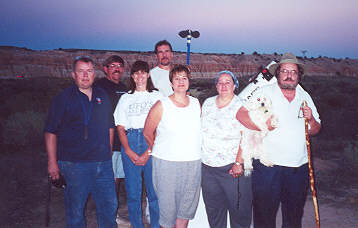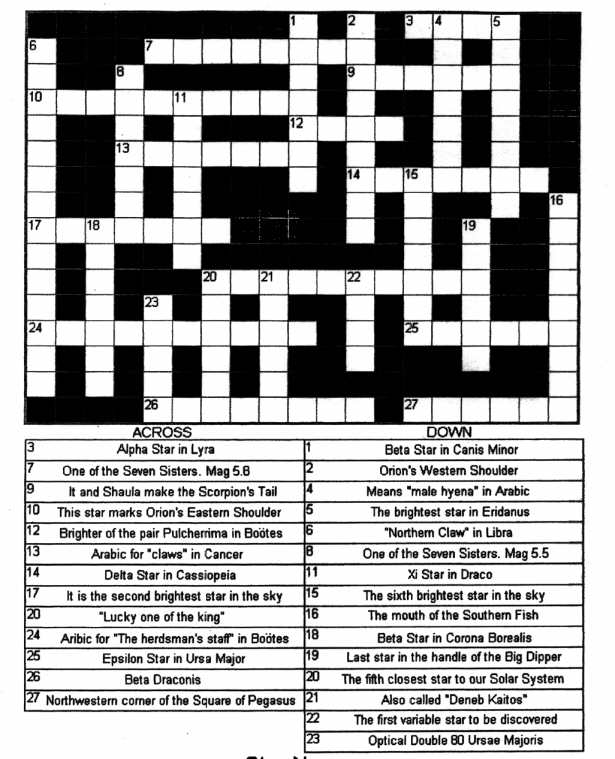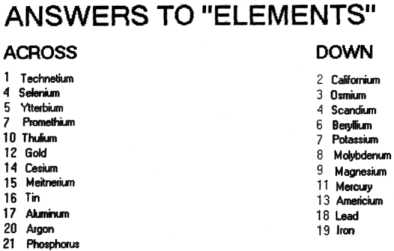
OAS Executive Committee
President- Dave Dunn, Ph. (801) 544-7705
Vice Pres- Lee Priest, Ph. (801) 479-5803
Secretary- Bob Tillotson, Ph. (801) 773-8106
Treasurer- Doug Say, (801) 731-7324
Vol. 30 Number 2 November 2000 http://physics.weber.edu/oas/oas.html
The monthly meeting of the Ogden Astronomical Society will convene in Weber State University's Ott Planetarium next Thursday November 9, 2000 at 7:30 p.m.
Membership cards will be available to pick up. Those members who did not retrieve their 2001 Astronomy calendar at the last meeting may do so at this meeting. Also, The Messier Marathon held at the Golden Spike Nation Monument camp ground was successful in spite of the questionable weather. Dave will discuss the event at this meeting, (and see below).
A video taped motion picture titled "Apollo 16 - Nothing So Hidden" will be shown. Dr. Sohl comments:
"This is a vintage NASA film that follows the Apollo 16 mission from start to end. It also shows a multi-million dollar "oops" and then discusses how they went about trying to fix it. One nice thing about this old video is that it shows that the Apollo Program was not 12 guys on the Moon but was an enormous effort involving large numbers of people on Earth that were busy in the background keeping things running. This is not a Ron Howard production, it is definitely from NASA, no chase scenes, but interesting viewing none-the-less. If nothing else, it is a good historical piece that few, if any, OAS members will have seen."
At the last meeting, many OAS members volunteered to support a star party at Bates Elementary School in North Ogden, Utah in November. However, the school faculty has decided to hold off on this activity until Spring. More information of the event will be forthcoming after a final date is set. Thanks to those who were planning to attend.
OAS and Roy Harmon's Store Cooperate To Promote Astronomy Everyone is encouraged to attend a public star party planned for this Friday November 3, 2000 at the Harmon's grocery store in Roy. Members will set up their telescope equipment in a darkened area of the parking lot just south west of the store. The store management is providing snacks and treats for the people and OAS members. The club is cooperating with Harmon's stores in order to bring astronomy to more people in the Weber County area. OAS information fliers will be available.
An invitation has been extended to members of the Salt Lake Astronomical Society, (SLAS) to also participate. SLAS is actively pursuing an ambitious observatory project at their Stansbury location in Tooele County. The members of SLAS have extended their thanks to the OAS for the invitation to attend and describe their project to the people of Weber County.
Telescopes, weather permitting, can be assembled before dusk. If the skies are good, members with solar filters are encouraged to set up early to allow people to view the sun.
For questions or directions, contact one of your Executive Committee members.
We held the Messier Marathon on 10/27 & 10/28. It turned out not to be very good for doing a marathon. We did have a nice 1 or 2 hour star party on
Friday night. Dale Hooper and I saw a very bright, fireball, green Taurid meteor. I only picked up 6 of the Messier objects. I also spent a little time viewing Saturn. A couple of hours after dark it clouded up.
On Saturday night, I was up their alone. I picked up a few more Messier objects but then I was distracted by Northern Lights. There was a red glow covering most of the northern horizon. What caught my attention was that part of it went all the way up though the Big Dippers bowl and even went on up into Draco. I sat and watched that for an hour or so and then when the clouds started in again I packed up and came home.
Dave Dunn
MINUTES
OGDEN ASTRONOMICAL SOCIETY
October 12, 2000
Club president Dave Dunn opened the October meeting by announcing the club's intentions for hosting another in the series of Messier Marathons. Contact has been made with the rangers at the Golden Spike National Monument. Camping will be available for those with trailers. Projected dates will be October 27 and 28.
Dave also noted that Harmons stores are inviting OAS to sponsor a public star party. The store in Roy has been scheduled for Friday November 3, 2000. The store will provide treats.
A Swap Meet is scheduled for this Saturday the 14th in Bountiful. Ron Vanderhule has arranged for the same location as last Spring. Everyone is welcome. Kim Hyatt is Ron's contact person.
Bob Tillotson disbursed Astronomy wall calendars that were ordered at last month's meeting. Alan Jensen is taking orders for the astronomy desk calendars. Cliff Peterson described an exciting star party he attended at Craters of the Moon in Idaho. Wayne Sumner is recruiting the OAS for a school star party at the Bates Elementary School in North Ogden. Further information will be announced.
The meeting moved forward with the evening's Show-and-Tell. Many members discussed and displayed their recent accomplishments.
The meeting adjourned at 9:00 p.m.
Bob Tillotson, Secretary
Last month, a hand full of OAS'ers loaded their vehicles and headed south to join the Las Vegas Astronomical Society (LVAS) for a star party in the desert. After driving through Cedar City we went west for about 80 miles and came to the Desert Valley of Cathedral Gorge, the location of the 14th annual Star Party sponsored by the Las Vegas Astronomical Society.

Mark Durrwachter traveled south with us. We
met up with fellow OAS'ers Deloy and Karen Pierce,
Ron and Karen Vanderhule and some of Ron's family.
After a warm welcome from the LVAS people we set up
our telescopes for three nights of the best astronomical
intoxication I have ever had; my head is still spinning.
The first night we spent most of the time getting
aquatinted with the Las Vegas group and checking out
their telescopes. The second night we looked at several
Messier objects, they were the clearest I have ever seen
them due to the dark skies of Eastern Nevada. We spent
most of the last night working with Brent Watson's book
of overlooked objects and found the Blue Snowball, the
Saturn Nebula, the Helix Nebula, the Bubble Nebula,
and the Fairy Ring; just to name a few. The Pot Luck
dinner on Saturday was a feast to behold. A raffle was
held and I came away with two prizes. We will definitely
return next year.

Lee Priest
OAS Vice President
Photographs in this article are by Lee Priest
Celestron Celestar 8-inch telescope with tripod. One year old and in excellent condition. Package includes reducer/corrector, hand controller and other accessories. Comes in its original box. $1,200.00. Contact:
P. Crippen
Ph. (801) 782-8855
Jim Seargeant's - Images
Planetary Nebula M27 (NGC 6853), in Vulpecula
This image of M27 was taken by four of Adam Johnston's Weber State students, Chris Hansen, Debbie DePierro, Ami Wilcox, and Geoff Wilson. It is a luminance-red-green-blue (LRGB) combination of five individual shots taken on 6 October. The luminance layer is a result of median combining two unfiltered 240 second images. The red, green, and blue images were of 240, 360, and 720 seconds exposure, respectively. The increased exposures for the green and blue shots are needed because of the Kodak KAF400 imaging chip's reduced sensitivity at those colors. All exposures were taken with a 12" Meade LX200 operating at f/6.3, SBIG ST7 CCD camera, SBIG CFW8 filter wheel, and were guided with a SBIG AO7.
The following information on M27 is taken from the Students for the Exploration and Development of Space (SEDS) web page at www.seds.org (with a couple of spelling corrections). I recommend a visit to SEDS to study the section on planetary nebula mentioned at the end of this piece.
"The Dumbbell Nebula M27 was the first planetary nebula ever discovered. On July 12, 1764, Charles Messier discovered this new and fascinating class of objects. We happen to see this one approximately from its equatorial plane (approx. left-to-right in our image); from near one pole, it would probably have the shape of a ring, and perhaps look like we view the Ring Nebula M57.
This planetary nebula is certainly the most impressive object of its kind in the sky, as the angular diameter of the luminous body is nearly 6 arc minutes, with a faint halo extending out to over 15', half the apparent diameter of the Moon. It is also among the brightest, being at most little less luminous with its estimated apparent visual magnitude 7.4 than the brightest, the Helix Nebula NGC 7293 in Aquarius, with 7.3, which however has a much lower surface brightness because of its larger extension (estimates from Stephen Hynes); it is a bit unusual that this planetary is only little fainter photographically (mag 7.6). The present author (hf) was surprised how fine this object was seen in his 10x50 binoculars under moderately good conditions !
The bright portion of the nebula is apparently expanding at a rate of 6.8 arc seconds per year, leading to an estimated age of 3000 to 4000 years, i.e. the shell ejection probably would have been observable this time ago (it actually happened earlier as the light had to travel all the distance of perhaps about 1000 light years).
The central star of M27 is quite bright at mag 13.5, and an extremely hot blueish subdwarf dwarf at about 85,000 K (so the spectral type is given as O7 in the Sky Catalog 2000). K.M. Cudworth of the Yerkes Observatory found that it probably has a faint (mag 17) yellow companion at 6.5" in position angle 214 deg (Burnham).
As for most planetary nebulae, the distance of M27 (and thus true dimension and intrinsic luminosity) is not very well known. Hynes gives about 800, Kenneth Glyn Jones 975, Mallas/Kreimer 1250 light years, while other estimates reach from 490 to 3500 light years. Currently, investigations with the Hubble Space Telescope are under work to determine a more reliable and accurate value for the distance of the Dumbbell Nebula.
Adopting our value of 1200 light years, the intrinsic luminosity of the gaseous nebula is about 100 times that of the Sun (about -0.5 Mag absolute) while the star is at about +6 (1/3 of the Sun) and the companion at +9..9.5 (nearly 100 times fainter than the Sun), all in the visual light part of the electromagnetic spectrum. That the nebula is so much brighter than the star shows that the star emits primarily highly energetic radiation of the non-visible part of the electro-magnetic spectrum, which is absorbed by exciting the nebula's gas, and re-emitted by the nebula, at last to a good part in the visible light. Actually, as for almost all planetary nebulae, most of the visible light is even emitted in one spectral line only, in the green light at 5007 Angstrom (see our planetary nebula description) ! "
Jim Seargeant
Editor's Note: To view Jim's beautiful photograph in color, see the OAS web site.
Crossword Challenge
by Jeremy Mathews
- Star Names -

Answers to Last Month's
Crossword Challenge

Note to all members:
The Star Diagonal is still searching for a generous contributing writer willing to prepare and submit an article once a month. Contact Bob Tillotson at: bob@skyplanner.com